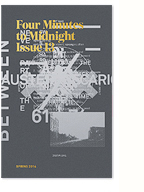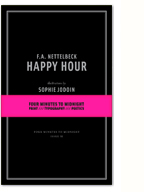Filed under: events,portfolio,reading and writing,type and typography
The following is a rough transcript of the presentation (in franglais) I gave last week at Pecha Kucha Night MTL. For those that are unfamiliar with the event’s format, presenters are asked to present 20 slides, commenting on each for 20 seconds, resulting in a fast-paced 6m40s presentation. More details about the event here.

01. This is my desk. The organisers asked me to focus on presenting process work tonight, and I think it’s equally important to always look at context, so here’s my desk, my after-hours working environment, and over the next few slides, I’ll explain a bit about who I am to further contextualise what I’m going to be presenting.

image by Post Typography
02. Je suis un designer graphique avec des tendances anarchiste. Ça veut dire quoi avoir des tendances anarchistes? Pour moi ça veut dire que je crois fortement dans la collectivité non-hierarchique, je m’alinge avec des luttes minoritaires, et que je suis un romantique sans espoir. Par contre je ne suis pas un member du AIGA, mais je trouvai l’illustration assez drole.

03. Ça fait longtemps que je travail dans le domain du web, depuis l’art ASCII et les BBS classiques. Je crois fortement dans l’interactivité comme modèle de communication. Voici quelques de mes travaux avec Bluesponge et Cossette ou je travaille comme directeur artistique. Je les montres ici en esperant que ça me donne un peu plus de crédibiliter avec vous ce soir…

04. I’d also consider myself a typographer, I’m obsessed with letters, words, and language generally. This is a spread from my personal bible, Robert Bringhurst’s Elements of Typographic Style. It’s from this book that I really learned to appreciate and use typography well, to value books as cultural objects and begin to understand the morality of good craft.

05. Four minutes to midnight is an experimental literary arts zine I design, edit, publish and distribute with my friend John Stuart. Tonight, I’ll be speaking of the journey this little publication has taken me through. It started out as part of my Master’s thesis at the London College of printing and based upon the really positive response we got, I decided to continue it as an independent project once I got back to Montreal.

image borrowed from flickr
06. Donc, j’avai déménager à Londres des Pays-Bas à cause d’un coeur briser… et étant romantique et anarchiste, j’ai blamé le capitalisme, avec son manufacture constant de désire pour le nouveau, pour mon rupture. Et ainsi, naturellement, mon réponse était d’essayer de partir un mouvement artistique anti-capitaliste…

07. Obviously though, I couldn’t really start an art movement as my thesis project, so what I decided to explore was the underground publications that surrounded these movements, tracing a lineage from the samzidat press of the early Russian avant-garde to the punk zines of the 70s. What really interested me was the ability of these small publications to create dynamic, politicized, creative communities.

08. Centrale à mon exploration était un approche théorique du dialogue présenter par le philosophe et physicist David Bohm. Pour lui, le dialogue est un modele de communication organique qui révele le “sens collectif” d’un groupe, étant opposer à le débat, qui essaye de prouver quelquechose ,ou le discussion, qui reste un forme analytique.

09. Here are some pages from the first issue of the zine. I had asked participants on my blog to send me quotes that they found inspiring within their own struggles and to answer the very generic question of “what’s wrong?” The results, which varied from the intensely personal to the overtly political, from the banal to the absurd, were then compiled to this first issue.

10.The idea was that each subsequent issue would be created from responses to the previous one. And since I was working with a lot of graphic designers, this is a sample of what I received for the second issue. Maya’s response was to isolate every instance of the word place and its surrounding words, while John’s occured from an overprinting error as he printed the first issue. These responses started to define the aesthetic approach of the publication.

11. As the “dialogue” progressed on the blog, over chat and email, two trends began to emerge. One, was the constant necessity to dig back into what had already been said in order to refocus the discussion and keep people interested and engaged, a leading from behind as it were. The other was the emergence of these beautiful fragments of raw poetry which led to the making of the 5th and final issue within the context of my thesis.

12. Here you can see me in my tiny apartment in London, surrounded by ink and paper pulling words and phrases together to create the issue. The result was a manifesto of sorts, collaged from the words of all the participants of the project, filtered through me. This approach would be the beginning of what I later dubbed the “fugue” a continuous, collective, typographic poem.

13. En retournant à Montréal, j’étai très impressioner par le réponse que mes petits magazines obscures avaient généré. J’ai reçu pleins d’emails encouragant et ça m’a ouvert la porte à travailler avec des artistes inspirants comme Brigitte Henry, Christopher David Ryan, JP King et Billy Mavreas, entre plein d’autres, pour les prochains numéros.

14. One collaboration that really exemplified the project was with the artist Nadia Myre. Here you can see her Scar Project workshop, where she invited the public into the gallery to sew their scars, both physical and emotional, onto canvas. I then traced these scars and remixed them back into the fugue producing the artwork above.

15. Voici un collage aléatoire de certains portions des pages des “fugues” présenter dans les dernières numéros. Celle-cis consiste des mots et des phrases de plus de 60 auteurs uniques, et je trouve cet idée en soi même vraiment beau. Dans le contexte du magazine, chaque fugue connecte et évolu du fugue précédent, étendant le “dialogue” au cours des annés.

16. This is John performing Fugue 8 in collaboration with OBX labs, where they employed speech recognition software to create these giant dynamic projections behind him.
So the fugue takes many forms, but is fundamentally an exploration, and defense of, collective language. Robert Bringhurst, speaking on morality and language, morality as language, had this to say:

17. “If one morality or language is superior to another, we will probably never know. But we notice all the time that one sentence, one speaker, or one conversation is better than another. In the same way, we sense the superiority of one or another piece of design–which is a kind of sentence after all as well as a fossilized moral transcation….

18. ….Those who empty words of their meanings are making themselves (and their neighbours and heirs) inarticulate. And a word is like a heartbeat or a breath. Meaning is squeezed out of it every time it is spoken. Then it needs to rest a moment in unspokenness, where it can fill with meaning again.”
This is the apartheid wall cutting through Israel/Palestine.

19. A month ago I signed a declaration with 500 Montréal artists supporting the call from Palestinian civil society for a campaign of Boycott, Divestment and Sanctions against the Israeli state. A week earlier, the Ontario legislature passed a unanimous motion condemning our actions as anti-semitic, bigoted, and promoting hate.

20. Not once did I read within the mainstream press any discussion of what Apartheid might mean, or whether it should apply to the policy of the Israeli government towards the Palestinian people. Only that we were racist assholes, criminals even, for using it. Words can mean hope, words can be weapons. I think I’ll leave it at that…
5 Comments so far
Leave a comment
nice ! sorry I missed…
Comment by triangles 04.07.10 @ 7:40 pmAre those AT-ATs on the back of the camel in slide 18?
Comment by P. Walters 03.29.11 @ 7:39 pmThat they are! It takes all kinds of “creatures” to tear down apartheid walls.
Comment by kevin 03.30.11 @ 2:03 pmI think that few people will use the word apartheid these days simply because of its very strong association in former years with South Africa.
Comment by Sam Weston 04.12.11 @ 5:04 amThe choice to use the word apartheid is very conscious, especially because of its association to South Africa. It charts a historic continuum of both persecution based on racism and strategies of successful resistance to this.
Comment by kevin 04.12.11 @ 2:26 pmLeave a comment














